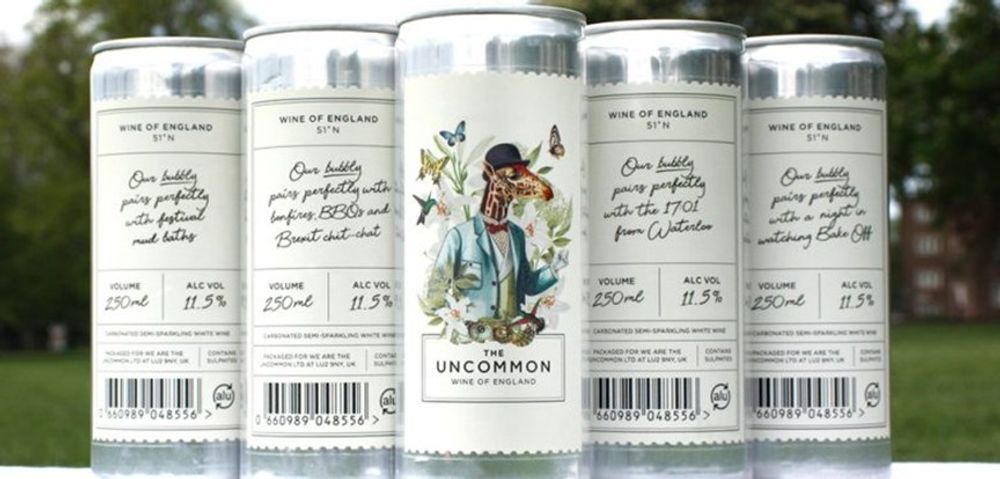It seems anything goes in the ever changing world of wines in a can as producers, importers, retailers and restaurant groups alike look to experiment and see what works best when put in a can.
It’s typical of the wine industry that when a potentially new, breakthrough, dynamic and, wait for it, potentially popular wine trend comes along then the sector immediately starts arguing with itself. Split between those who want to jump on board and do all they can to make this new opportunity work, and those who sit back and throw peanuts from the over populated wine trade gallery. Prosecco anyone? Pinot Grigio?
So it is with wine cans. Or wine in a can. Or the best or worst thing to happen in wine for years depending on which side of the glass half full, glass half empty debate you are on.
One thing for sure is canned wine has quickly become a category in its own right. Now how small or large that category will become is where the friction comes, but a category it is. Particularly in the US which has been at the forefront of the wine can market with now whole sections dedicated to canned wine in supermarkets and liquor stores.
Yes, it is still niche, but it is still an estimated $100m market in the US and it has only really got started.
Dr Robert Williams of WICresearch, a leading wine-in-a-can marketing research and consulting company, founded by Williams and colleagues from Texas Tech University, believes we can expect to see a step change in wine in cans in the US.

Interest in wine in cans is surging both in the trade and amongst consumers
“It’s already growing in very high double digits. We expect sales to explode. Our own database shows a 180% increase in the number of wineries producing wine in a can and a 157% increase in overall SKUs. Major drinks giants like AB InBev now has three win in can brands, and has said it wasn’t its Babe brand to become the Bud Light of the wine in can market. The top wineries in US all can now and we are seeing promotion budgets getting bigger.”
In June 2018, WICresearch says there were 125 winemakers producing 350 SKUs of wine in cans in 18 different US states. A year later, in June 2019, there were 350 winemakers producing 900 SKUs of wines in 28 states and 28 countries. That’s now increased to 375 winemakers producing 1,000 different SKUs of wine in cans.
Taken seriously
But it is not just in the US where producers, importers, retailers and bar group owners need to be taking cans seriously. For they only have to see what has happened in the craft beer sector where the heavily designed, in your face beer can has become the go to choice for everyday beer lovers as well as aficionados and beer geeks.
For now wine is scratching around the sides and seeing what works. But for those in the thick of the market, the new producers and brand owners, they can only see a bright future.
The fact a number of major, traditional bottling companies are now introducing canned lines to their facilities – like Greencroft in the UK – shows how seriously they are taking it and how many customers they are talking to are looking at wine in a can.

Paul Attwood-Phiippe says VINEX has seen a surge in interest in canned wine projects
VINEX, the online bulk and bottle wine trading site says it is seeing a big step up in interest from its members in cans. Paul Attwood-Philippe, business development director for Europe for VINEX, says it was currently working on up to 30 different canned wine projects with importers and bottlers. What was particularly interesting about these trials, he added, was that project leaders come more from a technical and winemaking background where the onus is on assessing what impact a can has on the quality of wine.
It also means they are being much more willing to test indigenous varieties from a wider range of countries, particularly Portugal and Austria, rather than look for a standard Cabernet Sauvignon or Merlot. “They are looking for something a bit more unusual that is in keeping with having a wine in a can,” he said. The kind of companies that are particularly interested in cans are mid tier importers in UK, Ireland and Germany, as well as bottlers in Germany and the Netherlands, he added.
What about quality?

What the naysayers about canned wine really get excited is the quality of the wine in a can, or at least perceived quality. How can a can be a good format for quality wine?
Well, a recent study by WICresearch might go some way to addressing those concerns. It interviewed 86 adults aged between 21 and 74. They used identical wine from same winery that had been canned and bottled, and poured the wine into a glass and asked people to taste them blind. They were asked to taste a dry Chardonnay, a dry Riesling, a dry rosé, and a sparkling sweet Moscato. Overall the result was split decision with 48.5% preferring the bottled wines, 45.3% the canned, and 5.8% had no preference between the two.
Even though 57% self-identified as having higher subjective wine knowledge than their peers, WIC found that they were just as likely to taste, purchase and enjoy wine in a can. Gender and age were also not a factor.
Appeal of cans
WIC says canned wine will increasingly appeal to people because of the following factors: convenience; the occasion or location; sustainability and cost savings; quality; portion control; choice and; imaging, branding and design.
It’s already, for example, a preferred format at many events and music and sports venues. In Japan, for example, canned wine is doing particularly well in c-stores and also in vending machines, ideal for people to sip on their commute home.
The environmental and sustainability factor will potentially appeal more to importers, retailers and operators alike as aluminium cans can be recycled multiple times, and offer a lighter, cheaper alternative to glass.
The US canned wine market could also receive a boost if a proposed change in the law comes in for no no can size limits above 50ml. Previously wine could only be sold in 187ml, 375ml and 500ml single serve, and 250ml could only be sold in 3 or 4-pack.
Williams at WIC believes this can only help give the US can market a boost. “It will spur growth. Our research indicates consumers want 250ml most. Having to buy a 4 pack, with is more than a bottle of wine, seems too expensive. Since our research indicates convenience and occasion are two big drivers of the wine in the can market, the 4 pack rule hinders growth by negating those benefits.”
Cans across the board

The Uncommon shows how ambitious canned wine is becoming with an English wine made from Bacchus in a can
For now canned wine has played more to the white and rosé side of the wine aisle, rather than bold reds, but Dr Williams sees that changing. “There is a Cabernet Sauvignon for $25/375ml ($50 bottle) from Sans, with a 93/100 score,” he says.
The key for canned wine is just so much choice there already is. Williams explains: “In our database of 350 wineries, who offer 900 SKUs, there are literally nearly 100 different types, from Albarino to Zinfadel”
What’s more as canned wine is still such a new market consumers are not as price sensitive as they are for bottled, wine, says Williams.
“Frankly, consumers are still learning about this packaging format,” he adds. “The market is in the process of segmenting into finer slices, based on factors such as varietal, can size, ABV, price, etc. Our data shows 375ml can is more a shared can, while 187ml and 250ml are more single-serve, with 250ml the clear preference.”
But as the market matures he believes it will become more specialised and we should “keep an eye on the craft-beerification of wine in cans” as well as keg wine packaging/wine-on-tap.
So where do you sit on the canned wine debate? Still undecided? Well in the UK there is now an English sparkling wine being bought and sold in pubs and restaurants thanks to the Uncommon which has brought Bacchus to cans and no doubt a lot of new UK consumers.
It’s going to be a fascinating category to watch.
- This is an adapted article from one first published on VINEX the bulk wine and bottling trading site.































